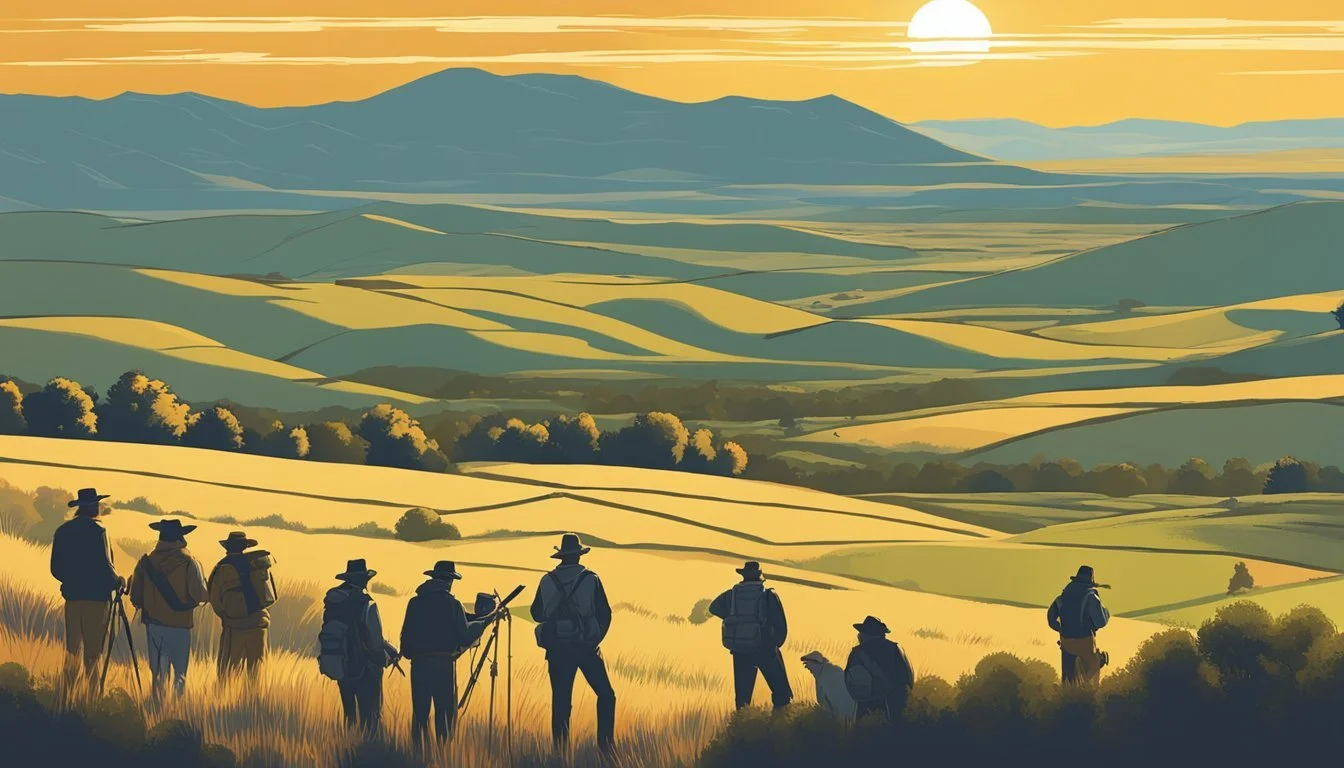Hunting Leases New Mexico
Your Guide to Securing Prime Land
New Mexico offers a diverse array of hunting opportunities, from big game species such as elk and mule deer to waterfowl and turkeys. Considering the vast landscapes and mixed property ownership between public and private lands, hunting leases have become a convenient way for hunters to gain access to prime hunting territories. These leases provide a system where private landowners can allow hunters to use their land, typically for a fee, which in turn can be beneficial for both land management and local economies.
Hunting leases vary in their offerings and terms, with some providing year-round access, and others designed for seasonal hunting. They may range from large ranches with extensive acreage to smaller parcels tailored to specific types of game. This flexibility in lease arrangements allows hunters to find suitable options that align with their preferences and hunting goals.
New Mexico's hunting leases are a testament to the state's commitment to wildlife conservation and management efforts. By fostering collaboration between private landowners and the hunting community, these leases contribute to the state's rich outdoor heritage and ensure sustainable hunting practices while respecting the habitat and wildlife populations.
Overview of Hunting Leases in New Mexico
New Mexico offers a diverse range of hunting leases on private lands catering to different hunting preferences. These leases provide a mutually beneficial arrangement for both hunters seeking quality game and landowners looking to manage wildlife.
State and County Regulations
New Mexico's hunting leases are subject to state and county regulations which ensure sustainable and ethical hunting practices. Prospective lessees should review the specific rules that may affect hunting on leased lands, including the species permissible to hunt, hunting methods, and seasons.
State Regulations: New Mexico Department of Game and Fish oversees hunting regulations.
County Regulations: Local laws may place additional constraints on hunting activities.
Types of Hunting Leases Available
Hunting leases in New Mexico vary widely to cater to different types of hunting:
Big Game Hunting: Leases are often sought for game such as elk, mule deer, and whitetail deer.
Small Game & Furbearer Hunting: Some leases allow hunting smaller species.
Waterfowl Hunting: Available private lands host migratory birds like geese and ducks.
This variety allows hunters to choose a lease best suited to their preferred wildlife habitat and hunting type.
Benefits of Leasing for Hunters and Landowners
Leasing property for hunting purposes provides benefits for both hunters and landowners:
For Hunters: Access to exclusive and well-managed private hunting lands can lead to a higher quality of game and a more successful hunting experience.
For Landowners: Leases can be a source of additional income and assist in managing wildlife populations on their ranch or property.
Finding Hunting Leases
When searching for hunting leases in New Mexico, enthusiasts have a couple of reliable options to consider - online platforms and direct lease agreements with private landowners. Each method offers its own set of benefits for securing the ideal hunting spot.
Online Hunting Lease Resources (HLRBO)
Hunting Lease Resource and Booking Online (HLRBO) emerges as a prominent intermediary, hosting an extensive selection of hunting leases. They provide:
Detailed listings with photographs and satellite maps
A search feature allowing users to filter by state, county, species, and more
User ratings and reviews for additional insights
Prospectors can tailor their search for land for lease by species, using the aforementioned search features to pinpoint the exact type of hunting experience they desire.
Leasing Through Private Landowners
Leasing directly through private landowners offers a more personal route, commonly resulting in long-term relationships and repeat leasing opportunities. Here, the advantages include:
Direct negotiation on lease terms and pricing
The potential for a more flexible and customized hunting experience
Insights into the land and its game directly from the landowner
Those interested in private hunting lands should engage with landowners to discuss expectations and ensure the lease meets their specific hunting types and needs. Agreements are typically arranged without the intermediary, potentially offering a more cost-effective solution.
Game Species and Seasons
Hunting in New Mexico offers a diverse array of wildlife and seasons, tailored to suit the pursuit of various game species across expansive and varied landscapes. The state's meticulously managed wildlife populations present optimal hunting opportunities within designated seasons that are established to promote ecological balance and sustainability.
Big Game Hunting Opportunities
In New Mexico, big game hunting is a prominent activity, attracting hunters seeking elk, deer, and pronghorn. Specifically, the state hosts a healthy population of elk, which can be pursued during designated seasons typically set from September to December. Mule deer and whitetail deer seasons also draw in hunters, offering a range of hunting experiences from archery to rifle, with varying dates often spanning from October to December. Pronghorn, known for their speed and agility, provide a unique challenge and their hunting seasons usually run in August and September.
Small Game and Upland Bird Hunting
For those interested in small game and birds, New Mexico's hunting landscapes provide ample opportunity. Quail (What wine goes well with quail?) hunting seasons typically run from November to February, inviting hunters to traverse the state's diverse terrain with a shotgun in hand. The state supports several species of quail, ensuring an engaging hunting experience. Similarly, upland bird hunting is a significant draw, with species such as doves and grouse available to hunt during their respective open seasons that align with the best times for population health and hunter success.
Exotic and Other Species
New Mexico is unique in offering regulated hunting seasons for certain exotic species, including Persian ibex, oryx, and Barbary sheep. These exotic hunts are typically managed through limited entry draw systems, ensuring the sustainability of both the species and the hunting experience. The hunting seasons for these exotics vary, with oryx hunts notably occurring year-round on private lands with appropriate licenses, while ibex and Barbary sheep have specific seasons usually set between October and March.
Lease Agreements and Criteria
When considering a hunting lease in New Mexico, it is essential to understand the lease terms and criteria governing the agreement. The clarity of the lease terms affects both the landowner and the lessee, while negotiating leasing contracts requires attention to detail and mutual understanding.
Understanding Lease Terms
Lease Type: Typically, leases are drafted as yearly leases, although duration can vary.
Property Description: Leases should clearly define the property boundaries and total acreage involved.
Hunting Types Allowed: Specify what type of hunting (big game, small game, etc.) is permitted.
Species: Detail which wildlife species can be pursued.
Access Rights: Outline how and when the lessee can access the property.
Criteria for Selection: Landowners may have specific criteria for selecting a lessee, such as experience, conservation practices, and adherence to state hunting regulations.
Negotiating Leasing Contracts
Engage in Clear Communication: Both parties need to discuss expectations, hunting practices, and land use.
Payment Terms: Establish the lease price, payment schedule, and any deposit required.
Liability and Insurance: Address who is responsible for insurance coverages.
Renewal Terms: Define conditions under which the lease might be renewed or terminated.
Be Prepared to Compromise: Negotiation is a give-and-take process where both landowners and lessees may need to adjust their expectations to reach an agreement.
Land Management and Conservation
In New Mexico, effective land management and conservation practices are crucial for enhancing wildlife habitat and promoting sustainable hunting. The collaboration between landowners and conservation programs supports the growth of healthy wildlife populations while maintaining the integrity of the natural landscape.
Enhancing Wildlife Habitat
Landowners in New Mexico play a pivotal role in wildlife habitat enhancement by participating in programs like the Open Gate Private Lands initiative. Through this program, they lease their lands for public recreational use such as hunting, thereby increasing habitat areas and encouraging biodiversity. Additionally, the Bureau of Land Management (BLM) oversees 13.5 million acres in New Mexico, fostering National Conservation Lands that are vital for wildlife habitats and ensuring ecological health. The enhancement efforts include:
Habitat restoration: Restoration projects aim to repair ecosystems to a sustainable state.
Food plots: These plots provide supplemental nutrition to wildlife, promoting population growth.
Sustainable Hunting Practices
Sustainable hunting in New Mexico is supported through strict enforcement of hunting licenses to manage wildlife populations responsibly. The New Mexico Department of Game & Fish provides guidelines and resources to ensure that hunting practices contribute to conservation and do not threaten the ecological balance. Key aspects include:
Hunting Leases: Leases help manage hunter numbers and ensure a balanced harvest of game species.
Hunting seasons and bag limits: Implemented to maintain healthy wildlife populations across the diverse species in the state.
By emphasizing conservation-centric practices, New Mexico ensures that its lands are managed sustainably, aligning the interests of hunters, landowners, and wildlife to create a harmonious outdoor environment.
Additional Activities on Leased Lands
Leased lands for hunting in New Mexico offer a variety of additional activities beyond hunting. These activities are designed to enhance the outdoor experience and support conservation efforts.
Camping and Recreational Use
On many leased hunting lands, landowners permit camping to accommodate hunters during their stay. This allows hunters to enjoy the immersive experience of living close to nature throughout the hunting season. Recreational use is often encouraged, respecting the balance of natural resource sustainability and the enjoyment of the outdoors.
Camping: Permitted on designated areas to support multi-day hunting trips.
Recreational Use: May include hiking, wildlife photography, and bird watching.
Trapping and Conservation Programs
Leased lands may be involved in trapping and wildlife conservation programs to manage species populations and contribute to ecological research. These programs are vital to maintaining the health of the ecosystems within the hunting acreage.
Trapping: Allowed under specific regulations to help control predator populations and for scientific study.
Conservation Programs: Contribute to habitat improvement and species surveys.
Geographic Focus for Hunting Leases
In New Mexico, hunters can access a range of terrains and habitats, with leases available across various counties and lands managed by different entities.
Popular Hunting Regions in New Mexico
New Mexico offers a diverse landscape for hunters, which includes the Gila National Forest and Carson National Forest. These forests are known for their sizable elk and deer populations. The state also includes regions such as Taos, which is popular for its big game hunting opportunities.
Gila National Forest: Predominantly located in the southwestern part of the state, it's a favored destination for hunting elk and deer.
Carson National Forest: Situated near Taos in the northern area, this forest provides habitats for various wildlife, including elk, mule deer, and turkey.
Counties across New Mexico also feature prominently in the hunting lease market, with areas like Rio Arriba offering extensive acreage for various hunting expeditions.
Bureau of Land Management (BLM) Lands
BLM lands in New Mexico cover millions of acres and offer vast public lands for hunting leases. These areas are managed for multiple uses, including recreation and conservation, providing opportunities for hunting:
BLM Land Usage: These public lands are accessible for hunting, subject to state regulations and seasonal restrictions.
Hunting Land Availability: Not all BLM lands are open for hunting; hunters should verify accessibility and lease terms for specific parcels.
Hunters interested in these lands should check the BLM's Land Office Geographic Information Center for up-to-date maps and lease information.
Financial Considerations
When evaluating the financial aspects of hunting leases in New Mexico, it's essential for landowners and hunters alike to understand the cost implications of leasing as opposed to outright land purchase, as well as the potential for investment in recreational hunting properties.
Cost of Leasing Land for Hunting
The cost to lease land for hunting in New Mexico varies widely and is influenced by factors such as location, acreage, and hunting lease market rates. Prices can range from $10 to $40 per acre, depending on the quality and type of game available. For example, a 40-acre hunting lease could potentially cost anywhere from $400 to $1,600 annually, representing a significant saving compared to land ownership costs, especially considering that a down payment alone for purchasing land could be around 20%.
Investment Potential in Recreational Hunting Lands
Investing in recreational hunting lands in New Mexico holds potential for those looking to generate supplemental income. When landowners rent out their property through hunting leases, the income can often offset costs for habitat improvements or even cover annual property taxes. However, it involves active management such as marketing the property, managing wildlife populations, and establishing connections with hunters. Despite the work involved, a well-managed hunting property can become a profitable venture, enriching the investment portfolio of the landowner.








